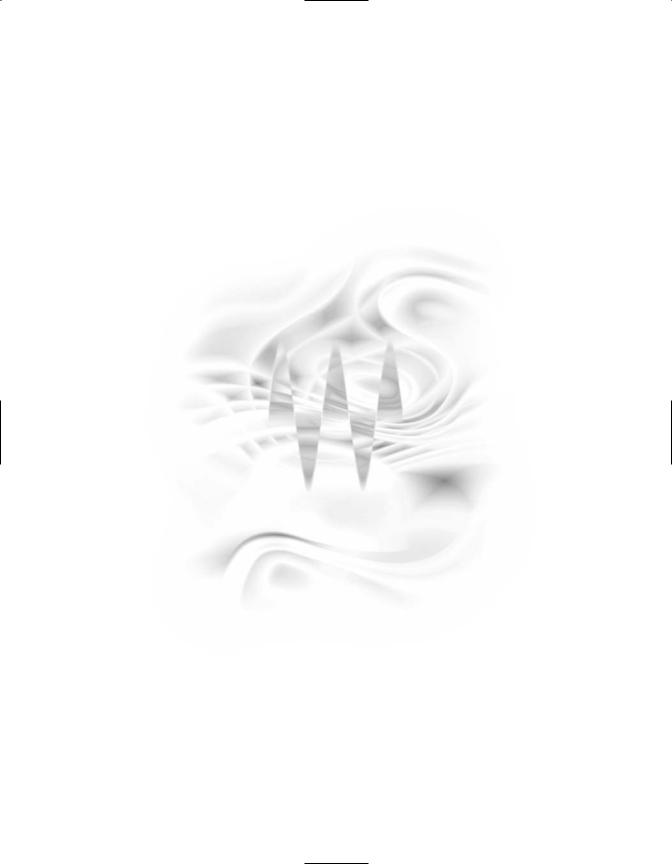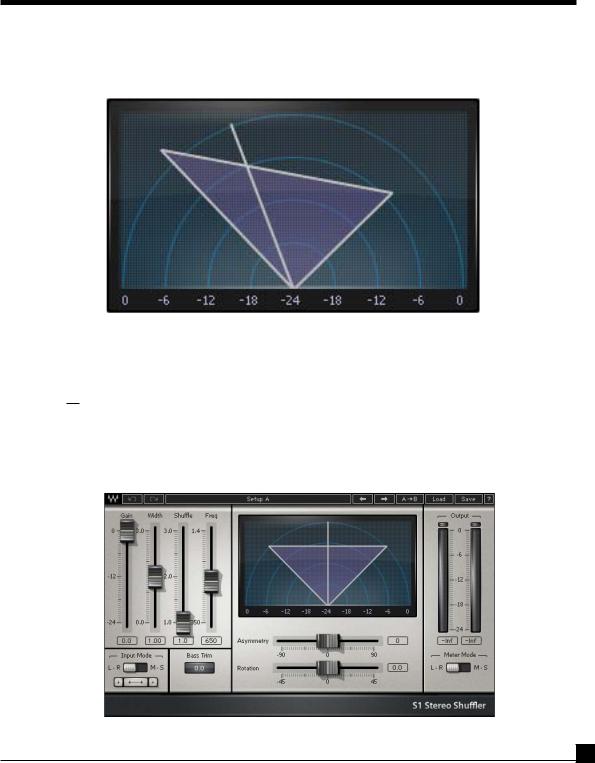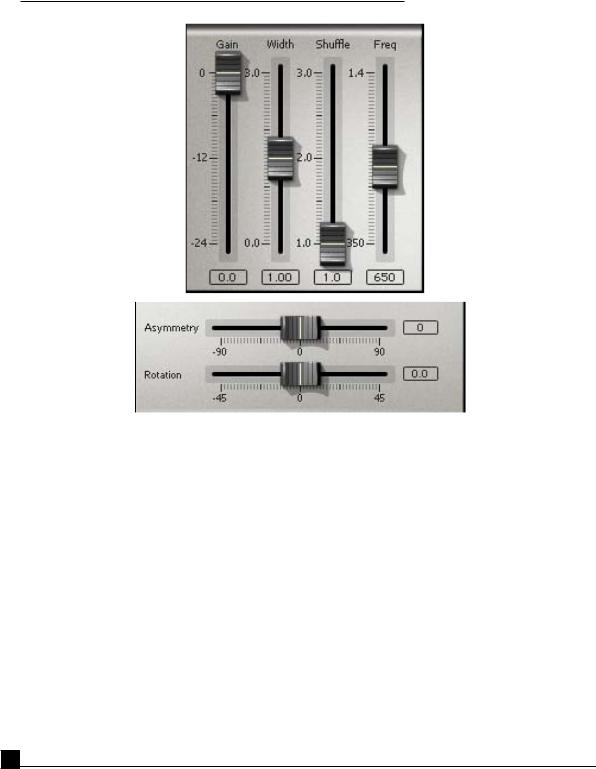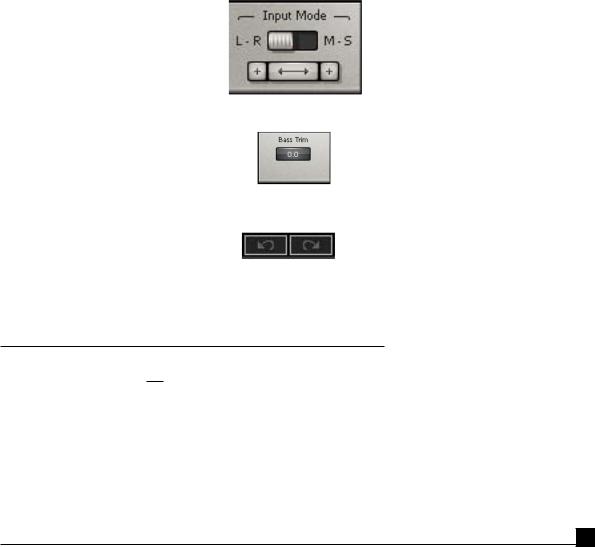Waves Audio S1 Stereo Imager User Guide

S1
Stereo Imager

Table of Contents |
|
|
Register Now! |
................... see WaveSystem Manual |
|
Chapter 1 ..................... |
About the S1 Stereo Imager .... 3 |
|
|
Before you start |
............ 3 |
|
Features and applications ............ |
3 |
|
S1 component plug-ins ........... |
4 |
Chapter 2 ....................................... |
The S1 Interface .... |
5 |
|
Stereo Vector Display™ ............ |
5 |
|
Quick guide screen shot ............ |
5 |
|
The Controls ............ |
6 |
|
Gain, Width ............ |
6 |
|
Asymmetry, Rotation, Shuffling, Frequency ............ |
6 |
|
LR/MS input, Bass Trim, Reset ............ |
7 |
|
Signal path (Order of action of controls) ............ |
7 |
Chapter 3 ............................................ |
Using the S1 .... 8 |
|
|
Graphical control ............ |
8 |
|
Hints for Use ............ |
8 |
|
Mastering and general use ............ |
9 |
|
To mix multiple stereo sources with S1 .......... |
10 |
|
Mono Compatibility .......... |
10 |
Chapter 4 ........................ |
About MS and MS modes .. 11 |
|
|
What is MS? .......... |
11 |
|
How is MS used? .......... |
12 |
|
Polarity/Channel swap in MS mode .......... |
12 |
|
Use of LR/MS meter mode .......... |
13 |
Chapter 5 .................................... |
Other S1 controls .. 14 |
|
|
Peak counters .......... |
14 |
|
Output clipping (the Gain control) .......... |
14 |
Chapter 6 ....................................... |
Special MS uses .. 15 |
|
|
Using the S1 MS options .......... |
15 |
|
MS Equalization .......... |
15 |
|
Uses of MS equalization .......... |
16 |
|
How to do: |
|
|
Overall EQ .......... |
16 |
|
Frequency-dependent width .......... |
16 |
|
One-point microphone compensation .......... |
17 |
|
FM broadcast noise reduction .......... |
17 |
|
One-sided equalization .......... |
17 |
S1 Plug-in Manual 1

Chapter 7 |
...............................More about shuffling .. 19 |
Chapter 8 ........................ |
History of stereo controls .. 20 |
Chapter 9 . What kind of stereo will the S1 work on? .. 21
Chapter 10 |
...................................... Key commands .. 22 |
Chapter 11.................................. |
Stereo monitoring .. 23 |
2S1 Plug-in Manual

Chapter 1 - About the S1 Stereo Imager
The S1-Stereo Imager combines a number of classical stereo processing techniques with Waves’ intuitive user interface to provide a powerful and unique ‘stereo toolkit’ for use in mastering and digital editing situations. S1 may be used to correct faults inherent in a stereo recording or mix, or it may be used to creatively enhance the stereoism of existing stereo material.
S1 is based on recognized engineering principles and does not purport to create a three-dimensional soundfield from a two-loudspeaker system or to create a pseudostereo master from a mono source. Because S1 is based on established audio engineering principles, it offers a high level of mono compatibility with minimal side effects.
S1 provides the means to readjust the stereo level-balance of a mix and has the ability to dramatically widen an existing stereo image, again without introducing significant side effects. For example, an assymetrical mix can be adjusted so as to re-balance the left and right components without affecting the position of the centre image or, alternatively, the center image may be panned left or right without affecting the balance of the stereo components of the mix.
Like all Waves plug-ins, S1 is based around a graphical interface and is designed to be both straightforward and intuitive to use. You can adjust all parameters via traditional numerical displays or directly from the graph, giving you the choice of interface and control.
Before you use S1, you should have a good working knowledge of both the host application software and your computer. If you’ve used a Waves plug-in before, you’ll probably be able to find your way around the S1 interface with minimal reference to this manual. However, we recommend you read it through at least once just so you know all the things S1 can do.
Before you start
Please make sure that your monitoring system is in phase and set up symmetrically about your normal listening position! This may seem obvious, but because S1 is designed to operate on the spatial aspects of a mix, it is imperative that your monitor system conveys an accurate sense of stereo imaging. If you have any concerns about your monitoring arrangement, please read the Stereo Monitoring chapter.
Features and applications
Particular care has been taken in the design of S1 to avoid unpleasant and fatiguing ‘phasiness’ effects and to retain a high level of mono compatibility. Mono sounds remain uncolored; S1 does not change the basic tonal character of the original sound, but simply sweetens and broadens the spaciousness of the stereo image.
A classic phase-compensated ‘shuffler’ is provided to both enhance the stereo spaciousness and improve the image quality at the bass end of the audio spectrum, again without introducing phasiness. The amount of shuffling and the range of frequencies affected are user-controllable so that the effect may be optimized for a variety of stereo source material.
The S1 Stereo Imager also has the unique capability of rebalancing a stereo mix, and of altering the positions within the stereo stage of individual parts of a stereo mix. By allowing the user to manipulate the relative balance
S1 Plug-in Manual 3

of the central, left and right stereo components of a mix, it is possible to ‘pan’ the left/right and center components independently. In addition, the relative balance of the left/right and center signal may be also changed to either narrow or widen the perceived stereo image. S1’s unique and informative stereo vector display allows the effect on level balance and positioning to be precisely visually monitored while making adjustments.
Stereo level metering is provided in both left/right and M/S modes so that the effect on stereoism can be fully monitored. As with some other Waves plug-ins, correction is provided for the two most common stereo imaging errors: channel polarity (‘phase’) errors and stereo channel reversal.
This stereo remix capability makes the S1 suitable not only for sweetening and enhancing adequately mixed stereo masters, but also for more drastic corrective and creative remix work. Because S1 doesn’t rely on gimmicky processes to achieve its results, it may be used to make subtle improvements even to refined ‘purist’ stereo recordings. The S1 does not add any unwanted sound effects not already present in the original recording. Rather it is designed to enhance and rebalance what is already there.
S1 Component plug-ins
On most host applications and platforms you can select just the audio processing you need, and use only the power necessary to do the job. The S1 has several plug-in components in the menu. They are all stereo-output- only plug-ins and can not be used for mono-to-mono processing. On some native platforms, 88.2/96kHz support is now available.
Here are the current components as of this printing; new ones may be added in future updates, and will be noted in the plug-in Read Me files. Some examples for each component are listed:
•S1 Shuffler — This is the full plug-in, with all controls, including Width, Rotation, Asymmetry, Shuffling, plus all channel controls (phase, gain, etc.), and does not count clips; (for mastering, to fix off-center or unbalanced mixes, precision image adjustment, change wideband width, expand low frequency image, Rotate true stereo sources without collapsing image, creation of strong antiphase content)
•S1 Shuffler (48) — The full mastering plug-in (TDM only!), same as the S1-Shuffler, but 48-bit double precision resolution; (applications same as S1 Shuffler but when increased resolution is needed)
•S1 Imager — Omits the Shuffler and Bass trim controls. Ideal for adjust Width, Rotation, and Asymmetry only; (saves processing power if Shuffling is not needed, excellent for stereo mixing to Rotate stereo-mic or submixes into place)
•S1 MS — Simply an MS converter (a matrix) that converts left-right input into MS output, (or vice versa). It has no controls or metering, and is designed so that if the input does not clip, neither will the output. Due to the nature of the matrix, the gain is reduced by 3dB in this process to avoid clipping. Therefore, if you use two MS modules in a chain (say for equalization of just the M or S channel), then the total chain will have a nominal signal drop of 6dB (3dB per MS module, also assuming the EQ is flat with unity gain).
4S1 Plug-in Manual

Chapter 2 - The S1 Interface
For complete information on basic Waves interface control, read the WaveSystem Manual.
The distinctive interface of the S1 lets you easily see and control the stereo soundstage of a file. The most noticeable feature of the interface is the stereo vector display, with its half-circle shape and soundstage graphic.
The stereo vector display of the S1.
The stereo vector display does not show anything about the input signal. It shows you:
1 - the output positions of the original left, center, and right sounds;
2 - an accurate indication of their changed levels in dB so you can adjust level-balance between original left, center, & right sounds.
The stereo vector display does not show the effect of shuffling, but only gain, width, asymmetry, & rotation. Shuffling is a process applied after these processes.
The S1 control interface.
S1 Plug-in Manual 5

The Controls
Gain - simply controls overall gain level without altering stereoism. Gain is displayed in dB.
Width - This alters the width of the input stereo signal. For width values less than 1, the sound stage is narrowed, becoming mono for width zero. For widths greater than 1, the sound stage is widened, with sounds at the two edges of the stereo stage being moved beyond the loudspeakers. The stereo is unchanged when Width equals 1. Start around 1.2 for moderate enhancement, plus a little Shuffling.
Asymmetry - This acts after initial width adjustment. This unique control does not affect central mono in-phase sounds in any way, but adjusts the relative level of left and right sounds. It differs from conventional balance control in that it keeps center sounds in the center. This control is particularly useful for altering the relative levels at the two sides of the stereo stage without moving a mix off-center, or biased in position to one side or the other.
Rotation control - This control allows adjustment of the centering of the entire stereo image without any effect on relative sound levels in different parts of the stereo stage. It is particularly useful for centering a stereo mix biased to one side of the stereo stage without altering the mix level balance, and for mixing stereo-miked sources, serving as a true stereo 'pan' control.
Useful tip: No separate stereo balance control is provided, but if you drag both the Asymmetry and Rotation controls together, then their combined effect is that of a balance control. For most platforms, they may be dragged together by dragging in the space between the two controls, or by selecting both controls first then dragging on one.
6S1 Plug-in Manual

Shuffling - This increases stereo width at bass frequencies to help compensate for the fact that the ears hear stereo effects as being more narrow in the bass than in the treble. Subjectively, it has the effect of making stereo images more spacious. Unlike previous commercially available stereo shufflers, it is fully phase compensated, i.e. does not introduce unwanted phase errors between the stereo channels. This gives improved stereo sound quality with low listening fatigue. It is also carefully designed to minimize tonal alterations of the mix in the bass. It comprises two controls: shuffling and frequency. Shuffling controls the magnitude of bass width increase between 1 (no shuffling) and 3 (maximum bass width increase). The subjectively best value usually lies between 1.6 and 2.5.
Frequency - controls the frequency below which the Shuffling effect is increased. This frequency may be adjusted between 350 and 1400 Hz. For normal stereo monitoring, a frequency between 600 and 700 Hz usually sounds best, although a higher frequency may be better if used with the very close loudspeakers often used in multimedia, portable, or TV one-piece reproducer systems where the stereo speakers are in the same box. A lower frequency is useful when adjusting stereo originating in stereo microphone techniques where the microphones are spaced apart by perhaps 20 or 30 centimeters.
LR/MS input button - Changes input mode to accept either standard Left-Right inputs or Mid/Side (MS) inputs. See the chapter About MS.
Bass Trim - Adjusts the level of bass when the Shuffler is in use. When set to 0, bass level stays more or less the same. On some material, higher Shuffler settings may need bass trim of 1 or 2 dB boost to compensate for any subjective shift in bass level.
Reset - This button restores Width, Asymmetry, Rotation and Shuffling to settings at which they have no effect on input stereo. Hint: By repeatedly using the Undo button after using Reset, you may do A/B comparisons between unprocessed and processed stereo effects, without altering gain or channel polarity and swap settings.
Signal path (Order of action of controls)
The controls act in the following order between input and output.
LR/MS input button to set input mode;
then Channel polarity to correct possible stereo phase errors on the input signal; then channel swap to correct possible stereo reversal on the input signal,
then Width,
Asymmetry,
Rotation,
Shuffling/frequency, and finally Gain.
S1 Plug-in Manual 7
